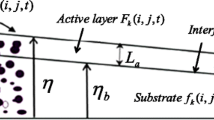Abstract
Predicting changes in alluvial channel morphology associated with anthropogenic and natural changes in flow and/or sediment supply is a critical part of the management of riverine systems. Over the past few years, advances in the understanding of the physics of sediment transport in conjunction with rapidly increasing capabilities in computational fluid dynamics, have yielded new approaches to problems in river mechanics. Techniques appropriate for length scales ranging from reaches to bars and bedforms are described here. Examples of the use of these computational approaches are discussed for three cases: (1) the design of diversion scenarios that maintain channel morphology in steep cobble-bedded channels in Colorado, (2) determination of channel maintenance flows for the preservation of channel islands in the Snake River in Idaho, and (3) prediction of the temporal evolution of deposits in lateral separation zones for future assessment of the impacts of various dam release scenarios on lateral separation deposits in the Colorado River in Grand Canyon. With continued development of their scientific and technical components, the methodologies described here can provide powerful tools for the management of river environments in the future.
Similar content being viewed by others
References
Andrews, E.D.: 1994,Water Resources Research,30, 2241–2250.
Jarrett, R.D.: 1989, in: B.C. Yen (ed.),Proceedings of the International Conference on Channel Flow and Catchment Runoff, 599–608.
Limerinos, J.T.: 1970, U. S. Geological Survey Professional Paper 282B.
McDonald, R.R. and Nelson, J.M.: 1994,Eos Transactions,75, 268.
Nelson, J.M.: 1991,Eos Transactions,72, 218.
Nelson, J.M., Emmett, W.W., and Smith, J.D.: 1991, in: S. Fan and Y. Kuo (eds),Proceedings of the Fifth Federal Interagency Sedimentation Conference, 55–62.
Nelson, J.M. and Smith, J.D.: 1989a, in: S. Ikeda and G. Parker (eds),River Meandering. Washington, D.C.: American Geophysical Union, 69–102.
Nelson, J.M. and Smith, J.D.: 1989b, in: S. Ikeda and G. Parker (eds),River Meandering. Washington, D.C.: American Geophysical Union, 321–377.
Parker, G., Klingeman, P.C. and McLean, D.G.: 1982,J. Hydraulics Div. ASCE.,108, 544–571.
Parker, R.S., Nelson, J.M., Elliott, J.G. and Carey, W.P.: 1992,Eos Transactions,73, 239.
Schmidt, J.C. and Graf, J.B.: 1990, U.S. Geological Survey Professional Paper 1493.
Wiberg, P.L. and Smith, J.D.: 1987,Water Resources Research,23, 1471–1480.
Wiberg, P.L. and Smith, J.D.: 1991,Water Resources Research,27, 825–838.
Author information
Authors and Affiliations
Rights and permissions
About this article
Cite this article
Nelson, J.M. Predictive techniques for river channel evolution and maintenance. Water Air Soil Pollut 90, 321–333 (1996). https://doi.org/10.1007/BF00619292
Published:
Issue Date:
DOI: https://doi.org/10.1007/BF00619292




